Economic complexity theory and applications
Economic complexity methods have become popular tools in economic geography, international development and innovation studies. Here, I review economic complexity theory and applications, with a particular focus on two streams of literature: the literature on relatedness, which focuses on the evolution of specialization patterns, and the literature on metrics of economic complexity, which uses dimensionality reduction techniques to create metrics of economic sophistication that are predictive of variations in income, economic growth, emissions and income inequality.
Keywords
- Economic complexity involves the use of machine learning and network techniques to predict and explain the economic trajectories of countries, cities and regions.
- Measures of relatedness — which estimate the affinity between economies and activities — anticipate changes in specialization patterns and explain labour market outcomes, such as income loss and unemployment.
- Economic complexity measures are reduced-dimensionality representations of specialization matrices that explain the geography of hundreds of economic activities.
- Measures of economic complexity explain and predict international and regional variations in income, economic growth, income inequality, gender inequality and greenhouse emissions.
- Economic complexity methods have been validated by studies at multiple geographic scales (from countries to cities) and a variety of economic activities (products, industries, occupations, patents, research papers).
- Relatedness metrics can be unpacked into multiple channels (such as industry, occupation and location-specific knowledge) to understand the drivers of regional diversification.
This is a preview of subscription content, access via your institution
Access options
Access Nature and 54 other Nature Portfolio journals
Get Nature+, our best-value online-access subscription
cancel any time
Subscribe to this journal
Receive 12 digital issues and online access to articles
111,02 € per year
only 9,25 € per issue
Buy this article
- Purchase on SpringerLink
- Instant access to full article PDF
Prices may be subject to local taxes which are calculated during checkout
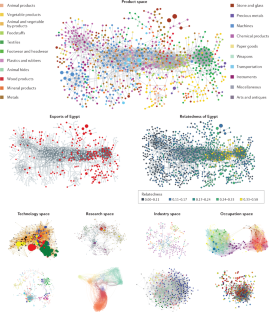
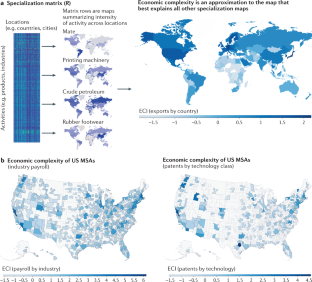
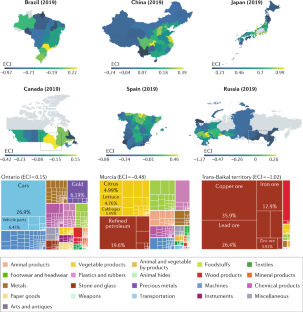


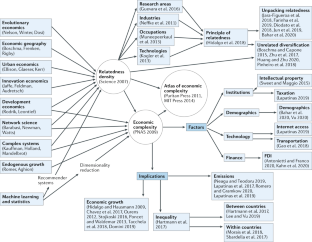
Similar content being viewed by others
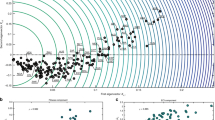
Reconciling contrasting views on economic complexity
Article Open access 03 July 2020

Correspondence analysis, spectral clustering and graph embedding: applications to ecology and economic complexity
Article Open access 26 April 2021
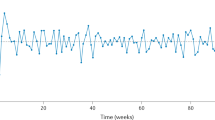
Foundations of complexity economics
Article 29 January 2021
References
- Beinhocker, E. D. The Origin of Wealth: Evolution, Complexity, and the Radical Remaking of Economics (Harvard Business School Press, 2006).
- Holland, J. H. & Miller, J. H. Artificial adaptive agents in economic theory. Am. Econ. Rev.81, 365–370 (1991). Google Scholar
- Miller, J. H. & Page, S. E. Complex Adaptive Systems: An Introduction to Computational Models of Social Life (Princeton Univ. Press, 2009).
- Kauffman, S. A. The Origins of Order: Self-Organization and Selection in Evolution (Oxford Univ. Press, 1993).
- Krugman, P. Complex landscapes in economic geography. Am. Econ. Rev.84, 412–416 (1994). Google Scholar
- Schelling, T. C. Micromotives and Macrobehavior (W.W. Norton & Company, 2006).
- Hidalgo, C. A., Klinger, B., Barabási, A.-L. & Hausmann, R. The product space conditions the development of nations. Science317, 482–487 (2007). ADSGoogle Scholar
- Hidalgo et al. in Unifying Themes in Complex Systems IX (eds Morales, A. J., Gershenson, C., Braha, D., Minai, A. A. & Bar-Yam, Y.) 451–457 (Springer International Publishing, 2018).
- Hidalgo, C. A. & Hausmann, R. The building blocks of economic complexity. Proc. Natl Acad. Sci. USA106, 10570–10575 (2009). ADSGoogle Scholar
- Hartmann, D., Guevara, M. R., Jara-Figueroa, C., Aristarán, M. & Hidalgo, C. A. Linking economic complexity, institutions, and income inequality. World Dev.93, 75–93 (2017). Google Scholar
- Neffke, F., Henning, M. & Boschma, R. How do regions diversify over time? Industry relatedness and the development of new growth paths in regions. Econ. Geogr.87, 237–265 (2011). Google Scholar
- Neffke, F. & Henning, M. Skill relatedness and firm diversification. Strategic Manag. J.34, 297–316 (2013). Google Scholar
- Kogler, D. F., Rigby, D. L. & Tucker, I. Mapping knowledge space and technological relatedness in US cities. Eur. Plan. Stud.21, 1374–1391 (2013). Google Scholar
- Boschma, R., Balland, P.-A. & Kogler, D. F. Relatedness and technological change in cities: the rise and fall of technological knowledge in US metropolitan areas from 1981 to 2010. Ind. Corp. Change24, 223–250 (2015). Google Scholar
- Guevara, M. R., Hartmann, D., Aristarán, M., Mendoza, M. & Hidalgo, C. A. The research space: using career paths to predict the evolution of the research output of individuals, institutions, and nations. Scientometrics109, 1695–1709 (2016). Google Scholar
- Muneepeerakul, R., Lobo, J., Shutters, S. T., Goméz-Liévano, A. & Qubbaj, M. R. Urban economies and occupation space: can they get “there” from “here”? PLoS ONE8, e73676 (2013). ADSGoogle Scholar
- Alabdulkareem, A. et al. Unpacking the polarization of workplace skills. Sci. Adv.4, eaao6030 (2018). ADSGoogle Scholar
- Chinazzi, M., Gonçalves, B., Zhang, Q. & Vespignani, A. Mapping the physics research space: a machine learning approach. EPJ Data Sci.8, 33 (2019). Google Scholar
- Hausmann, R. et al. The Atlas of Economic Complexity: Mapping Paths to Prosperity (MIT Press, 2014).
- Stojkoski, V., Utkovski, Z. & Kocarev, L. The impact of services on economic complexity: service sophistication as route for economic growth. PLoS ONE11, e0161633 (2016). Google Scholar
- Tacchella, A., Mazzilli, D. & Pietronero, L. A dynamical systems approach to gross domestic product forecasting. Nat. Phys.14, 861–865 (2018). Google Scholar
- Poncet, S. & de Waldemar, F. S. Economic complexity and growth. Rev. Écon.64, 495–503 (2013). Google Scholar
- Domini, G. Patterns of Specialisation and Economic Complexity Through the Lens of Universal Exhibitions, 1855–1900 LEM Papers Series 2019/20 (Laboratory of Economics and Management (LEM), 2019).
- Ourens, G. Can the Method of Reflections Help Predict Future Growth? Documento de Trabajo/FCS-DE; 17/12 (Universidad de la Republica, 2012).
- Chávez, J. C., Mosqueda, M. T. & Gómez-Zaldívar, M. Economic complexity and regional growth performance: evidence from the Mexican economy. Rev. Reg. Stud.47, 201–219 (2017). Google Scholar
- Zhu, S., Yu, C. & He, C. Export structures, income inequality and urban-rural divide in China. Appl. Geogr.115, 102150 (2020). Google Scholar
- Sbardella, A., Pugliese, E. & Pietronero, L. Economic development and wage inequality: a complex system analysis. PLoS ONE12, e0182774 (2017). Google Scholar
- Bandeira Morais, M., Swart, J. & Jordaan, J. A. Economic Complexity and Inequality: Does Productive Structure Affect Regional Wage Differentials in Brazil? USE Working Paper Series (Utrecht University, 2018).
- Fawaz, F. & Rahnama-Moghadamm, M. Spatial dependence of global income inequality: The role of economic complexity. Int. Trade J.33, 542–554 (2019). Google Scholar
- Neagu, O. & Teodoru, M. C. The relationship between economic complexity, energy consumption structure and greenhouse gas emission: heterogeneous panel evidence from the EU countries. Sustainability11, 497 (2019). Google Scholar
- Can, M. & Gozgor, G. The impact of economic complexity on carbon emissions: evidence from France. Environ. Sci. Pollut. Res.24, 16364–16370 (2017). Google Scholar
- Lapatinas, A., Garas, A., Boleti, E. & Kyriakou, A. Economic complexity and environmental performance: evidence from a world sample. MDPI Open Access J.12, 1–18 (2019). Google Scholar
- Romero, J. P. & Gramkow, C. Economic complexity and greenhouse gas emissions. World Dev.139, 105317 (2021). Google Scholar
- Mazzucato, M. The entrepreneurial state. Soundings49, 131–142 (2011). Google Scholar
- Rodrik, D. Where are we in the economics of industrial policies? Front. Econ. China14, 329–336 (2019). Google Scholar
- Balland, P. A., Boschma, R., Crespo, J. & Rigby, D. L. Smart specialization policy in the European Union: relatedness, knowledge complexity and regional diversification. Reg. Stud.53, 1252–1268 (2018). Google Scholar
- Foray, D., David, P. A. & Hall, B. Smart specialisation–the concept. Knowl. Econ. Policy Brief.9, 100 (2009). Google Scholar
- Montresor, S. & Quatraro, F. Green technologies and Smart Specialisation Strategies: a European patent-based analysis of the intertwining of technological relatedness and key enabling technologies. Reg. Stud.54, 1354–1365 (2019). Google Scholar
- Zheng, S., Sun, W., Wu, J. & Kahn, M. E. Urban Agglomeration and Local Economic Growth in China: The Role of New Industrial Parks. Social Science Research Network (SSRN)https://papers.ssrn.com/abstract=2746711 (2016).
- Kahn, M. E., Sun, W., Wu, J. & Zheng, S. The Revealed Preference of the Chinese Communist Party Leadership: Investing in Local Economic Development versus Rewarding Social Connections. National Bureau of Economic Research (NBER)http://www.nber.org/papers/w24457 (2018).
- De Waldemar, F. S. & Poncet, S. Product relatedness and firm exports in China. World Bank Econ. Rev.51, 104Ð118 (2013). Google Scholar
- Rigby, D. L. Technological relatedness and knowledge space: entry and exit of US cities from patent classes. Reg. Stud.49, 1922–1937 (2015). Google Scholar
- Essletzbichler, J. Relatedness, industrial branching and technological cohesion in US metropolitan areas. Reg. Stud.49, 752–766 (2015). Google Scholar
- Balland, P.-A. & Rigby, D. The geography of complex knowledge. Econ. Geogr.93, 1–23 (2017). Google Scholar
- Fritz, B. S. L. & Manduca, R. A. The economic complexity of US metropolitan areas. Preprint at arXivhttps://arxiv.org/abs/1901.08112 (2019).
- Farinha, T., Balland, P.-A., Morrison, A. & Boschma, R. What drives the geography of jobs in the US? unpacking relatedness. Ind. Innov.26, 988–1022 (2019). Google Scholar
- Guo, Q. & He, C. Production space and regional industrial evolution in China. GeoJournal82, 379–396 (2017). Google Scholar
- He, C. & Zhu, S. Evolutionary Economic Geography in China (Springer Singapore, 2019).
- Gao, J. & Zhou, T. Quantifying China’s regional economic complexity. Phys. A Stat. Mech. Appl.492, 1591–1603 (2018). Google Scholar
- Gao, J., Jun, B., Pentland, A. “Sandy”, Zhou, T. & Hidalgo, C. A. Collective learning in China’s regional economic development. Preprint at arXivhttps://arxiv.org/abs/1703.01369 (2017).
- Chen, Z., Poncet, S. & Xiong, R. Inter-industry relatedness and industrial-policy efficiency: evidence from China’s export processing zones. J. Comp. Econ.45, 809–826 (2017). Google Scholar
- Ferrarini, B. & Scaramozzino, P. The product space revisited: China’s trade profile. World Econ.38, 1368–1386 (2015). Google Scholar
- Pérez Hernández, C. C., Salazar Hernández, B. C. & Mendoza Moheno, J. Diagnóstico de la complejidad económica del estado de Hidalgo: de las capacidades a las oportunidades. Rev. Mex. Econ. Finanz.14, 261–277 (2019). Google Scholar
- Zaldívar, F. G., Molina, E., Flores, M., Zaldívar, M. & de Jesús Gómez Zaldívar, M. Economic complexity of the special economic zones in Mexico: opportunities for diversification and industrial sophistication. Ens. Rev. Econ.38, 1–40 (2019). Google Scholar
- Wang, Y. & Turkina, E. Economic complexity, product space network and Quebec’s global competitiveness. Can. J. Adm. Sci.37, 334–349 (2019). Google Scholar
- Lyubimov, I. L., Lysyuk, M. V. & Gvozdeva, M. A. Atlas of economic complexity, Russian regional pages. Vopr. Econ.https://doi.org/10.32609/0042-8736-2018-6-71-91 (2018). ArticleGoogle Scholar
- Lyubimov, I., Gvozdeva, M., Kazakova, M. & Nesterova, K. Economic complexity of Russian regions and their potential to diversify. J. New Econ. Assoc.34, 94–122 (2017). Google Scholar
- Jara-Figueroa, C., Jun, B., Glaeser, E. L. & Hidalgo, C. A. The role of industry-specific, occupation-specific, and location-specific knowledge in the growth and survival of new firms. Proc. Natl Acad Sci. USA115, 12646–12653 (2018). ADSGoogle Scholar
- Swart, J. & Brinkmann, L. in Universities and Sustainable Communities: Meeting the Goals of the Agenda 2030 (eds Filho, L., Tortato, U. & Frankenberger, F.) 3–45 (Springer, 2020).
- Dordmond, G., de Oliveira, H. C., Silva, I. R. & Swart, J. The complexity of green job creation: an analysis of green job development in Brazil. Environ. Dev. Sustain. https://doi.org/10.1007/s10668-020-00605-4 (2020).
- Britto, G., Romero, J., Freitas, E. & Coelho, C. The great divide: economic complexity and development paths in Brazil and South Korea. Blucher Eng. Proc.3, 1404–1425 (2016). Google Scholar
- Gala, P. Complexidade Economica: Uma Nova Perspectiva Para Entender a Antiga Questao da Riqueza das Nacoes (Contraponto, 2017).
- Ferreira-Coimbra, N. & Vaillant, M. Evolución del espacio de productos exportados:¿ está Uruguay en el lugar equivocado? Rev. Econ.16, 97–146 (2009). Google Scholar
- Reynolds, C. et al. A sub-national economic complexity analysis of Australia’s states and territories. Reg. Stud.52, 715–726 (2018). Google Scholar
- Erkan, B. & Yildirimci, E. Economic complexity and export competitiveness: the case of Turkey. Procedia Soc. Behav. Sci.195, 524–533 (2015). Google Scholar
- Hartmann, D. in International Innovation Networks and Knowledge Migration (eds Pyka, A., Kuştepeli, Y. & Hartmann, D.) 53–71 (Routledge, 2016).
- Coşkun, N., Lopcu, K. & Tuncer, İ. The economic complexity approach to development policy: where Turkey stands in comparison to OECD plus China? Proc. Middle East Econ. Assoc.20, 112–124 (2018). Google Scholar
- Boschma, R., Minondo, A. & Navarro, M. The emergence of new industries at the regional level in Spain: a proximity approach based on product relatedness. Econ. Geogr.89, 29–51 (2013). Google Scholar
- Cicerone, G., McCann, P. & Venhorst, V. A. Promoting regional growth and innovation: relatedness, revealed comparative advantage and the product space. J. Econ. Geogr.20, 293–316 (2020). Google Scholar
- Basile, R., Cicerone, G. & Iapadre, L. Economic complexity and regional labor productivity distribution: evidence from Italy. Rev. Reg. Stud.47, 201–219 (2019). Google Scholar
- Innocenti, N. & Lazzeretti, L. Do the creative industries support growth and innovation in the wider economy? Industry relatedness and employment growth in Italy. Ind. Innov.26, 1152–1173 (2019). Google Scholar
- Innocenti, N. & Lazzeretti, L. Related variety and employment growth in Italy. Sci. Reg.16, 325–350 (2017). Google Scholar
- Innocenti, N. & Lazzeretti, L. Growth in regions, knowledge bases and relatedness: some insights from the Italian case. Eur. Plan. Stud.27, 2034–2048 (2019). Google Scholar
- González, A., Ortigoza, E., Llamosas, C., Blanco, G. & Amarilla, R. Multi-criteria analysis of economic complexity transition in emerging economies: the case of Paraguay. Socio-Econ. Plan. Sci.63, 100617 (2018). Google Scholar
- Mealy, P. & Coyle, D. To Them That Hath: Economic Complexity and Local Industrial Strategy in the UK (Elsevier, 2019).
- Bishop, A. & Mateos-Garcia, J. Exploring the link between economic complexity and emergent economic activities. Natl Inst. Econ. Rev.249, R47–R58 (2019). Google Scholar
- Maes, P. in Readings in Human–Computer Interaction (eds Baecker, R. M., Grudin, J., Buxton, W. A. S. & Greenberg, S.) 811–821 (Morgan Kaufmann, 1995).
- Resnick, P. & Varian, H. R. Recommender systems. Commun. ACM40, 56–58 (1997). Google Scholar
- Romer, P. M. Endogenous technological change. J. Polit. Econ.98, S71–S102 (1990). Google Scholar
- Aghion, P. & Howitt, P. A model of growth through creative destruction. Econometrica60, 323–351 (1992). MATHGoogle Scholar
- Warsh, D. Knowledge and the Wealth of Nations: A Story of Economic Discovery (W.W. Norton & Company, 2007).
- Jaffe, A. B., Trajtenberg, M. & Henderson, R. Geographic localization of knowledge spillovers as evidenced by patent citations. Q. J. Econ.108, 577–598 (1993). Google Scholar
- Feldman, M. P. & Florida, R. The geographic sources of innovation: technological infrastructure and product innovation in the United States. Ann. Assoc. Am. Geogr.84, 210–229 (1994). Google Scholar
- Audretsch, D. B. & Feldman, M. P. in Handbook of Regional and Urban Economics Vol. 4 Ch. 61 (eds Henderson, J. V. & Thisse, J.-F.) 2713–2739 (Elsevier, 2004).
- Audretsch, D. B. & Feldman, M. P. R&D spillovers and the geography of innovation and production. Am. Econ. Rev.86, 630–640 (1996). Google Scholar
- Boschma, R. Proximity and innovation: a critical assessment. Reg. Stud.39, 61–74 (2005). Google Scholar
- Breschi, S., Lissoni, F. & Malerba, F. Knowledge-relatedness in firm technological diversification. Res. Policy32, 69–87 (2003). Google Scholar
- Breschi, S. & Lissoni, F. Mobility of skilled workers and co-invention networks: an anatomy of localized knowledge flows. J. Econ. Geogr.9, 439–468 (2009). Google Scholar
- Breschi, S. & Lissoni, F. in Handbook of Quantitative Science and Technology Research (eds Moed, H. F., Glänzel, W. & Schmoch, U.) 613–643 (Springer, 2004).
- Singh, J. Collaborative networks as determinants of knowledge diffusion patterns. Manag. Sci.51, 756–770 (2005). MATHGoogle Scholar
- Collins, H. Tacit and Explicit Knowledge (Univ. Chicago Press, 2010).
- Collins, H. M. The TEA set: tacit knowledge and scientific networks. Sci. Stud.4, 165–185 (1974). Google Scholar
- Hidalgo, C. Why Information Grows: The Evolution of Order, from Atoms to Economies (Basic Books, 2015).
- Florida, R. The world is spiky. Atlantic Mon.296, 48–51 (2005). Google Scholar
- Balland, P.-A. et al. Complex economic activities concentrate in large cities. Nat. Hum. Behav.4, 248–254 (2020). Google Scholar
- Weaver, W. Science and complexity. Am. Sci.36, 536–544 (1948). Google Scholar
- Cohen, W. M. & Levinthal, D. A. Absorptive capacity: a new perspective on learning and innovation. Adm. Sci. Q.35, 128–152 (1990). Google Scholar
- Ellison, G. & Glaeser, E. L. Geographic concentration in US manufacturing industries: a dartboard approach. J. Polit. Econ.105, 889–927 (1997). Google Scholar
- Almeida, P. & Kogut, B. Localization of knowledge and the mobility of engineers in regional networks. Manag. Sci.45, 905–917 (1999). Google Scholar
- Bellet, M., Colletis, G. & Lung, Y. Économie de proximités. Rev. Econ. Reg. Urbaine3, 357–608 (1993). Google Scholar
- Carrincazeaux, C., Lung, Y. & Vicente, J. The scientific trajectory of the French school of proximity: interaction-and institution-based approaches to regional innovation systems. Eur. Plan. Stud.16, 617–628 (2008). Google Scholar
- Rallet, A. & Torre, A. Proximité géographique ou proximité organisationnelle? Une analyse spatiale des coopérations technologiques dans les réseaux localisés d’innovation, 54, 147–171 (HAL INRAE, 2001).
- Glaeser, E. L., Kallal, H. D., Scheinkman, J. A. & Shleifer, A. Growth in cities. J. Polit. Econ.100, 1126–1152 (1992). Google Scholar
- Frenken, K., Oort, F. V. & Verburg, T. Related variety, unrelated variety and regional economic growth. Reg. Stud.41, 685–697 (2007). Google Scholar
- Ellison, G. & Glaeser, E. L. The geographic concentration of industry: does natural advantage explain agglomeration? Am. Econ. Rev.89, 311–316 (1999). Google Scholar
- Saviotti, P. P. & Frenken, K. Export variety and the economic performance of countries. J. Evol. Econ.18, 201–218 (2008). Google Scholar
- Boschma, R. & Frenken, K. in Beyond Territory. Dynamic Geographies of Knowledge Creation, Diffusion and Innovation (eds Bathelt, H., Feldman, M. & Kogler, D.) 64–68 (Routledge, 2012).
- Porter, M. E. Clusters and the New Economics of Competition (Harvard Business Review, 1998).
- Porter, M. E. The Competitive Advantage of Nations (Simon and Shuster, 1990).
- Shutters, S. T., Muneepeerakul, R. & Lobo, J. Constrained pathways to a creative urban economy. Urban Stud.53, 3439–3454 (2016). Google Scholar
- Knuepling, L. & Broekel, T. Does relatedness drive the diversification of countries’ success in sports? Eur. Sport Manag. Q.https://doi.org/10.1080/16184742.2020.1770830 (2020). ArticleGoogle Scholar
- Klement, B. & Strambach, S. How do new music genres emerge? Diversification processes in symbolic knowledge bases. Reg. Stud.53, 1447–1458 (2019). Google Scholar
- Dosi, G. in Diffusion of Technologies and Social Behavior (eds Nakićenović, N. & Grübler, A.) 179–208 (Springer, 1991).
- Dosi, G., Freeman, C., Nelson, R., Silverberg, G. & Soete, L. (eds) Technical Change and Economic Theory (Pinter Publishers, 1988).
- Nelson, R. R. & Winter, S. G. An Evolutionary Theory of Economic Change (Belknap Press of Harvard University Press, 1982).
- Fleming, L. & Sorenson, O. Technology as a complex adaptive system: evidence from patent data. Res. Policy30, 1019–1039 (2001). Google Scholar
- Archibugi, D. & Coco, A. A new indicator of technological capabilities for developed and developing countries (ArCo). World Dev.32, 629–654 (2004). Google Scholar
- Lall, S. Indicators of the relative importance of IPRs in developing countries. Res. Policy32, 1657–1680 (2003). Google Scholar
- Desai, M., Fukuda-Parr, S., Johansson, C. & Sagasti, F. Measuring the technology achievement of nations and the capacity to participate in the network age. J. Hum. Dev.3, 95–122 (2002). Google Scholar
- Hausmann, R., Hwang, J. & Rodrik, D. What you export matters. J. Econ. Growth12, 1–25 (2007). MATHGoogle Scholar
- Tacchella, A., Cristelli, M., Caldarelli, G., Gabrielli, A. & Pietronero, L. A new metrics for countries’ fitness and products’ complexity. Sci. Rep.2, srep00723 (2012). MATHADSGoogle Scholar
- Cristelli, M., Gabrielli, A., Tacchella, A., Caldarelli, G. & Pietronero, L. Measuring the intangibles: a metrics for the economic complexity of countries and products. PLoS ONE8, e70726 (2013). MATHADSGoogle Scholar
- Ivanova, I., Strand, Ø., Kushnir, D. & Leydesdorff, L. Economic and technological complexity: a model study of indicators of knowledge-based innovation systems. Technol. Forecast. Soc. Change120, 77–89 (2017). Google Scholar
- Ivanova, I., Smorodinskaya, N. & Leydesdorff, L. On measuring complexity in a post-industrial economy: The ecosystem’s approach. Qual. Quantity54, 197–212 (2020). Google Scholar
- AlQurtas, A. M. A New Indicator of Economic Complexity to Guide Industrial Policies (George Washington University, 2018).
- Xu, M. & Lybbert, T. J. Innovation-adjusted Economic Complexity and Growth: Does Product-Specific Patenting Reveal Enhanced Economic Capabilities? (University of California, 2019).
- Petralia, S., Balland, P.-A. & Morrison, A. Climbing the ladder of technological development. Res. Policy46, 956–969 (2017). Google Scholar
- Wohl, I. The Method of Reflections and US Occupational Employment (U.S. International Trade Commission, 2020).
- Ferraz, D., Moralles, H. F., Campoli, J. S., de Oliveira, F. C. R. & Rebelatto, D. A. Economic complexity and human development: DEA performance measurement in Asia and Latin America. Gestão Produção25, 839–853 (2018). Google Scholar
- Lapatinas, A. Economic complexity and human development: a note. Econ. Bull.36, 1441–1452 (2016). Google Scholar
- Neagu, O. The link between economic complexity and carbon emissions in the European Union countries: a model based on the environmental Kuznets Curve (EKC) approach. Sustainability11, 4753 (2019). Google Scholar
- Simoes, A. J. G. & Hidalgo, C. A. in Workshops at the Twenty-Fifth AAAI Conference on Artificial Intelligence (MIT Media Lab, 2011).
- Bahar, D., Rosenow, S., Stein, E. & Wagner, R. Export take-offs and acceleration: Unpacking cross-sector linkages in the evolution of comparative advantage. World Dev.117, 48–60 (2019). Google Scholar
- Jun, B., Alshamsi, A., Gao, J. & Hidalgo, C. A. Bilateral relatedness: knowledge diffusion and the evolution of bilateral trade. J. Evol. Econ.30, 247–277 (2019). Google Scholar
- Boschma, R. & Capone, G. Institutions and diversification: Related versus unrelated diversification in a varieties of capitalism framework. Res. Policy44, 1902–1914 (2015). Google Scholar
- Zhu, S., He, C. & Zhou, Y. How to jump further and catch up? Path-breaking in an uneven industry space. J. Econ. Geogr.17, 521–545 (2017). Google Scholar
- Huang, Y. & Zhu, S. Regional industrial dynamics under the environmental pressures in China. J. Clean. Prod.265, 121917 (2020). Google Scholar
- Diodato, D., Neffke, F. & O’Clery, N. Why do industries coagglomerate? How Marshallian externalities differ by industry and have evolved over time. J. Urban Econ.106, 1–26 (2018). Google Scholar
- Pugliese, E. et al. Unfolding the innovation system for the development of countries: coevolution of Science, Technology and Production. Sci. Rep.9, 16440 (2019). ADSGoogle Scholar
- Catalán, P., Navarrete, C. & Figueroa, F. The scientific and technological cross-space: is technological diversification driven by scientific endogenous capacity? Res. Policyhttps://doi.org/10.1016/j.respol.2020.104016 (2020). ArticleGoogle Scholar
- Neffke, F. M., Otto, A. & Hidalgo, C. The mobility of displaced workers: How the local industry mix affects job search. J. Urban Econ.108, 124–140 (2018). Google Scholar
- Delgado, M., Porter, M. E. & Stern, S. Clusters, convergence, and economic performance. Res. Policy43, 1785–1799 (2014). Google Scholar
- Hamwey, R., Pacini, H. & Assunção, L. Mapping green product spaces of nations. J. Environ. Dev.22, 155–168 (2013). Google Scholar
- Mealy, P. & Teytelboym, A. Economic complexity and the green economy. Res. Policyhttps://doi.org/10.1016/j.respol.2020.103948 (2017). ArticleGoogle Scholar
- Huberty, M. & Zachmann, G. Green Exports and the Global Product Space: Prospects for EU Industrial Policy (Bruegel, 2011).
- Fraccascia, L., Giannoccaro, I. & Albino, V. Green product development: what does the country product space imply? J. Clean. Prod.170, 1076–1088 (2018). Google Scholar
- Perruchas, F., Consoli, D. & Barbieri, N. Specialisation, diversification and the ladder of green technology development. Res. Policy49, 103922 (2020). Google Scholar
- Delgado, M., Porter, M. E. & Stern, S. Clusters and entrepreneurship. J. Econ. Geogr.10, 495–518 (2010). Google Scholar
- Alshamsi, A., Pinheiro, F. L. & Hidalgo, C. A. Optimal diversification strategies in the networks of related products and of related research areas. Nat. Commun.9, 1328 (2018). ADSGoogle Scholar
- Marrocu, E., Paci, R., Rigby, D. & Usai, S. Smart Specialization Strategy: Any Relatedness Between Theory and Practice? (University of Cagliari and University of Sassari, 2020).
- Uhlbach, W.-H., Balland, P.-A. & Scherngell, T. R&D Policy and Technological Trajectories of Regions: Evidence from the EU Framework Programmes (Bruegel, 2017).
- Lee, K.-K. & Vu, T. V. Economic complexity, human capital and income inequality: a cross-country analysis. Jpn. Econ. Rev.71, 695–718 (2019). Google Scholar
- Ben Saâd, M. & Assoumou-Ella, G. Economic complexity and gender inequality in education: an empirical study. Econ. Bull.39, 321–334 (2019). Google Scholar
- Barza, R., Jara-Figueroa, C., Hidalgo, C. & Viarengo, M. Knowledge Intensity and Gender Wage Gaps: Evidence from Linked Employer–Employee Data (University of Munich, 2020).
- Le Caous, E. & Huarng, F. Economic complexity and the mediating effects of income inequality: reaching sustainable development in developing countries. Sustainability12, 2089 (2020). Google Scholar
- Güneri, B. & Yalta, A. Y. Does economic complexity reduce output volatility in developing countries? Bull. Econ. Res.https://doi.org/10.1111/boer.12257 (2020). ArticleGoogle Scholar
- Sweet, C. & Eterovic, D. Do patent rights matter? 40 years of innovation, complexity and productivity. World Dev.115, 78–93 (2019). Google Scholar
- Vu, T. V. Economic complexity and health outcomes: a global perspective. Soc. Sci. Med.265, 113480 (2020). Google Scholar
- Lapatinas, A., Kyriakou, A. & Garas, A. Taxation and economic sophistication: evidence from OECD countries. PLoS ONE14, e0213498 (2019). Google Scholar
- Sweet, C. M. & Eterovic Maggio, D. S. Do stronger intellectual property rights increase innovation? World Dev.66, 665–677 (2015). Google Scholar
- Vu, T. V. Does Institutional Quality Foster Economic Complexity? (University of Otago, 2019).
- Bahar, D., Rapoport, H. & Turati, R. Birthplace diversity and econoimc complexity: Cross-country evidence. Res. Policyhttps://doi.org/10.1016/j.respol.2020.103991 (2020).
- Vu, T. V. Does LGBT Inclusion Promote National Innovative Capacity? Social Science Research Network (SSRN)https://papers.ssrn.com/abstract=3523553 (2020).
- Lapatinas, A. The effect of the Internet on economic sophistication: An empirical analysis. Econ. Lett.174, 35–38 (2019). Google Scholar
- Demir, F. IMF Conditionality, Trade Structure and Economic Complexity: What Did Structural Adjustment Programs Really Adjust? (University of Oklahoma, 2019).
- Bustos, S., Gomez, C., Hausmann, R. & Hidalgo, C. A. The dynamics of nestedness predicts the evolution of industrial ecosystems. PLoS ONE7, e49393 (2012). ADSGoogle Scholar
- Bahar, D., Hausmann, R. & Hidalgo, C. A. Neighbors and the evolution of the comparative advantage of nations: evidence of international knowledge diffusion? J. Int. Econ.92, 111–123 (2014). Google Scholar
- Boschma, R., Eriksson, R. & Lindgren, U. How does labour mobility affect the performance of plants? The importance of relatedness and geographical proximity. J. Econ. Geogr.9, 169–190 (2009). Google Scholar
- Csáfordi, Z., Lőrincz, L., Lengyel, B. & Kiss, K. M. Productivity spillovers through labor flows: Productivity gap, multinational experience and industry relatedness. J. Technol. Transf.45, 86–121 (2018). Google Scholar
- Börner, K. et al. Design and update of a classification system: The UCSD map of science. PLoS ONE7, e39464 (2012). ADSGoogle Scholar
- Pinheiro, F. L., Alshamsi, A., Hartmann, D., Boschma, R. & Hidalgo, C. A. Shooting high or low: do countries benefit from entering unrelated activities? Preprint at arXivhttps://arxiv.org/abs/1801.05352 (2018).
- Arvis, J.-F. How Many Dimensions do we Trade in? Product Space Geometry and Latent Comparative Advantage (The World Bank, 2013).
- Utkovski, Z., Pradier, M. F., Stojkoski, V., Perez-Cruz, F. & Kocarev, L. Economic complexity unfolded: interpretable model for the productive structure of economies. PLoS ONE13, e0200822 (2018). Google Scholar
- Che, N. Intelligent Export Diversification: an Export Recommendation System with Machine Learning (International Monetary Fund, 2020).
- Hill, M. O. Reciprocal averaging: an eigenvector method of ordination. J. Ecol.61, 237–249 (1973). Google Scholar
- Mealy, P., Farmer, J. D. & Teytelboym, A. Interpreting economic complexity. Sci. Adv.5, eaau1705 (2019). ADSGoogle Scholar
- Caldarelli, G. et al. A network analysis of countries’ export flows: firm grounds for the building blocks of the economy. PLoS ONE7, e47278 (2012). ADSGoogle Scholar
- Felipe, J., Kumar, U., Abdon, A. & Bacate, M. Product complexity and economic development. Struct. Change Econ. Dyn.23, 36–68 (2012). Google Scholar
- Lizardo, O. The mutual specification of genres and audiences: Reflective two-mode centralities in person-to-culture data. Poetics68, 52–71 (2018). Google Scholar
- Page, L., Brin, S., Motwani, R. & Winograd, T. The Pagerank Citation Ranking: Bringing Order to the Web (Stanford InfoLab, 1999).
- Servedio, V. D., Buttà, P., Mazzilli, D., Tacchella, A. & Pietronero, L. A new and stable estimation method of country economic fitness and product complexity. Entropy20, 783 (2018). ADSGoogle Scholar
- Ellison, G., Glaeser, E. L. & Kerr, W. R. What causes industry agglomeration? evidence from coagglomeration patterns. Am. Econ. Rev.100, 1195–1213 (2010). Google Scholar
- Boschma, R., Heimeriks, G. & Balland, P.-A. Scientific knowledge dynamics and relatedness in biotech cities. Res. Policy43, 107–114 (2014). Google Scholar
- Morales, E., Sheu, G. & Zahler, A. Gravity and Extended Gravity: Estimating a Structural Model of Export Entry (University Library of Munich, 2011).
- Chaney, T. The network structure of international trade. Am. Econ. Rev.104, 3600–3634 (2014). Google Scholar
- Cortinovis, N., Xiao, J., Boschma, R. & van Oort, F. G. Quality of government and social capital as drivers of regional diversification in Europe. J. Econ. Geogr.17, 1179–1208 (2017). Google Scholar
- Neffke, F. M., Otto, A. & Weyh, A. Inter-industry labor flows. J. Econ. Behav. Organ.142, 275–292 (2017). Google Scholar
- Hausmann, R. & Neffke, F. M. H. The workforce of pioneer plants: the role of worker mobility in the diffusion of industries. Res. Policy48, 628–648 (2019). Google Scholar
- Borggren, J., Eriksson, R. H. & Lindgren, U. Knowledge flows in high-impact firms: How does relatedness influence survival, acquisition and exit? J. Econ. Geogr.16, 637–665 (2016). Google Scholar
- Diodato, D. & Weterings, A. B. The resilience of regional labour markets to economic shocks: Exploring the role of interactions among firms and workers. J. Econ. Geogr.15, 723–742 (2015). Google Scholar
- Miguelez, E. & Moreno, R. Relatedness, external linkages and regional innovation in Europe. Reg. Stud.52, 688–701 (2018). Google Scholar
- Kekezi, O. & Boschma, A. R. Returns to Migration After Job Loss – The Importance of Job Match (Utrecht University, 2020).
- Nedelkoska, L., Neffke, F. & Wiederhold, S. in Annual Meeting of the American Economic Association (American Economic Association, 2015).
- Santoalha, A. & Boschma, R. Diversifying in green technologies in European regions: does political support matter? Reg. Stud. https://doi.org/10.1080/00343404.2020.1744122 (2020).
- Adam, A., Garas, A. & Lapatinas, A. Economic Complexity and Jobs: An Empirical Analysis (University Library of Munich, 2019).
- Cristelli, M., Tacchella, A. & Pietronero, L. The heterogeneous dynamics of economic complexity. PLoS ONE10, e0117174 (2015). Google Scholar
- Balsalobre, S. J. P., Verduras, C. L. & Lanchas, J. D. Measuring the Economic Complexity at the Sub-National Level Using International and Interregional Trade (Autonomous University of Madrid, 2017).
- Zhu, S. & Li, R. Economic complexity, human capital and economic growth: empirical research based on cross-country panel data. Appl. Econ.49, 3815–3828 (2017). Google Scholar
- Coniglio, N. D., Lagravinese, R. & Vurchio, D. Production sophisticatedness and growth: evidence from Italian provinces before and during the crisis, 1997–2013. Camb. J. Reg. Econ. Soc.9, 423–442 (2016). Google Scholar
- Lo Turco, A. & Maggioni, D. The knowledge and skill content of production complexity. Res. Policyhttps://doi.org/10.1016/j.respol.2020.104059 (2020). ArticleGoogle Scholar
- Buccellato, T. & Corò, G. in Capitalism, Global Change and Sustainable Development (ed. Paganetto, L.) 149–167 (Springer International Publishing, 2020)
- Kuznets, S. Economic growth and income inequality. Am. Econ. Rev.45, 1–28 (1955). Google Scholar
- Chu, L. K. & Hoang, D. P. How does economic complexity influence income inequality? New evidence from international data. Econ. Anal. Policy68, 44–57 (2020). Google Scholar
- Dong, Z., Chen, W. & Wang, S. Emission reduction target, complexity and industrial performance. J. Environ. Manag.260, 110148 (2020). Google Scholar
- Chu, L. K. Economic structure and environmental Kuznets curve hypothesis: new evidence from economic complexity. Appl. Econ. Lett. https://doi.org/10.1080/13504851.2020.1767280 (2020).
- Doğan, B., Saboori, B. & Can, M. Does economic complexity matter for environmental degradation? An empirical analysis for different stages of development. Environ. Sci. Pollut. Res.26, 31900–31912 (2019). Google Scholar
- Güneri, B. Economic complexity and economic performance. Res. Policyhttps://doi.org/10.1016/j.respol.2020.103948 (2020). ArticleGoogle Scholar
- Hausmann, R. & Hidalgo, C. A. The network structure of economic output. J. Econ. Growth16, 309–342 (2011). Google Scholar
- Weitzman, M. L. Recombinant growth. Q. J. Econ.113, 331–360 (1998). MathSciNetMATHGoogle Scholar
- Fink, T. M. A., Reeves, M., Palma, R. & Farr, R. S. Serendipity and strategy in rapid innovation. Nat. Commun.8, 2002 (2017). ADSGoogle Scholar
- Hidalgo, C. A. Economic complexity: from useless to keystone. Nat. Phys.14, 9–10 (2018). Google Scholar
- Gomez-Lievano, A., Patterson-Lomba, O. & Hausmann, R. Explaining the prevalence, scaling and variance of urban phenomena. Nat. Hum. Behav.1, 0012 (2018). Google Scholar
- Bettencourt, L. M. A., Lobo, J., Helbing, D., Kühnert, C. & West, G. B. Growth, innovation, scaling, and the pace of life in cities. Proc. Natl Acad. Sci. USA104, 7301–7306 (2007). ADSGoogle Scholar
- Waniek, M., Elbassioni, K., Pinheiro, F. L., Hidalgo, C. A. & Alshamsi, A. Computational aspects of optimal strategic network diffusion. Theor. Comput. Sci.814, 153–168 (2020). MathSciNetMATHGoogle Scholar
- Lee, K. & Ki, J. Rise of latecomers and catch-up cycles in the world steel industry. Res. Policy46, 365–375 (2017). Google Scholar
- Lee, K. & Malerba, F. Catch-up cycles and changes in industrial leadership: Windows of opportunity and responses of firms and countries in the evolution of sectoral systems. Res. Policy46, 338–351 (2017). Google Scholar
- Arthur, W. B. Positive feedbacks in the economy. Sci. Am.262, 92–99 (1990). Google Scholar
- Antonietti, R. & Franco, C. From FDI to economic complexity: a panel Granger causality analysis. Struct. Chang. Econ. Dyn.https://doi.org/10.1016/j.strueco.2020.11.001 (2020). ArticleGoogle Scholar
- Khan, H., Khan, U. & Khan, M. A. Causal nexus between economic complexity and FDI: empirical evidence from time series analysis. Chinese Econ.53, 374–394 (2020). Google Scholar
- Ozsoy, S., Fazlioglu, B. & Esen, S. Do FDI and patents drive sophistication of exports? A panel data approach. Prague Econ. Pap. https://doi.org/10.18267/j.pep.755 (2020).
- Hamilton, A. Report on Manufactures (Good Press, 1791).
- Tinits, P. & Sobchuk, O. Open-ended cumulative cultural evolution of Hollywood film crews. Evol. Hum. Sci. https://doi.org/10.1017/ehs.2020.21 (2020).
- Yu, A. Z., Ronen, S., Hu, K., Lu, T. & Hidalgo, C. A. Pantheon 1.0, a manually verified dataset of globally famous biographies. Sci. Data3, 1–16 (2016). Google Scholar
- Ronen, S. et al. Links that speak: the global language network and its association with global fame. Proc. Natl Acad. Sci. USA111, E5616–E5622 (2014). Google Scholar
- Hidalgo, C. A. The Dynamics of Economic Complexity and the Product Space Over a 42 Year Period (Harvard University, 2009).
- Kuusk, K. & Martynovich, M. Dynamic nature of relatedness, or what kind of related variety for long-term regional growth. Tijdschr. Econ. Soc. Geogr.https://doi.org/10.1111/tesg.12427 (2020).
- Juhász, S., Broekel, T. & Boschma, R. Explaining the dynamics of relatedness: the role of co‐location and complexity. Pap. Reg. Sci.https://doi.org/10.1111/pirs.12567 (2020).
- Hidalgo, C. A., Castañer, E. & Sevtsuk, A. The amenity mix of urban neighborhoods. Habitat Int.106, 102205 (2020). Google Scholar
- Koch, P. Economic complexity and growth: can value-added exports better explain the link?. Econ. Lett.198, 109682 (2021). Google Scholar
Acknowledgements
The author thanks Pierre-Alexandre Balland, Cristian Jara-Figueroa and Mary Kaltenberg for their useful comments. This work was supported by ANITI (ANR-19-PI3A-0004).










